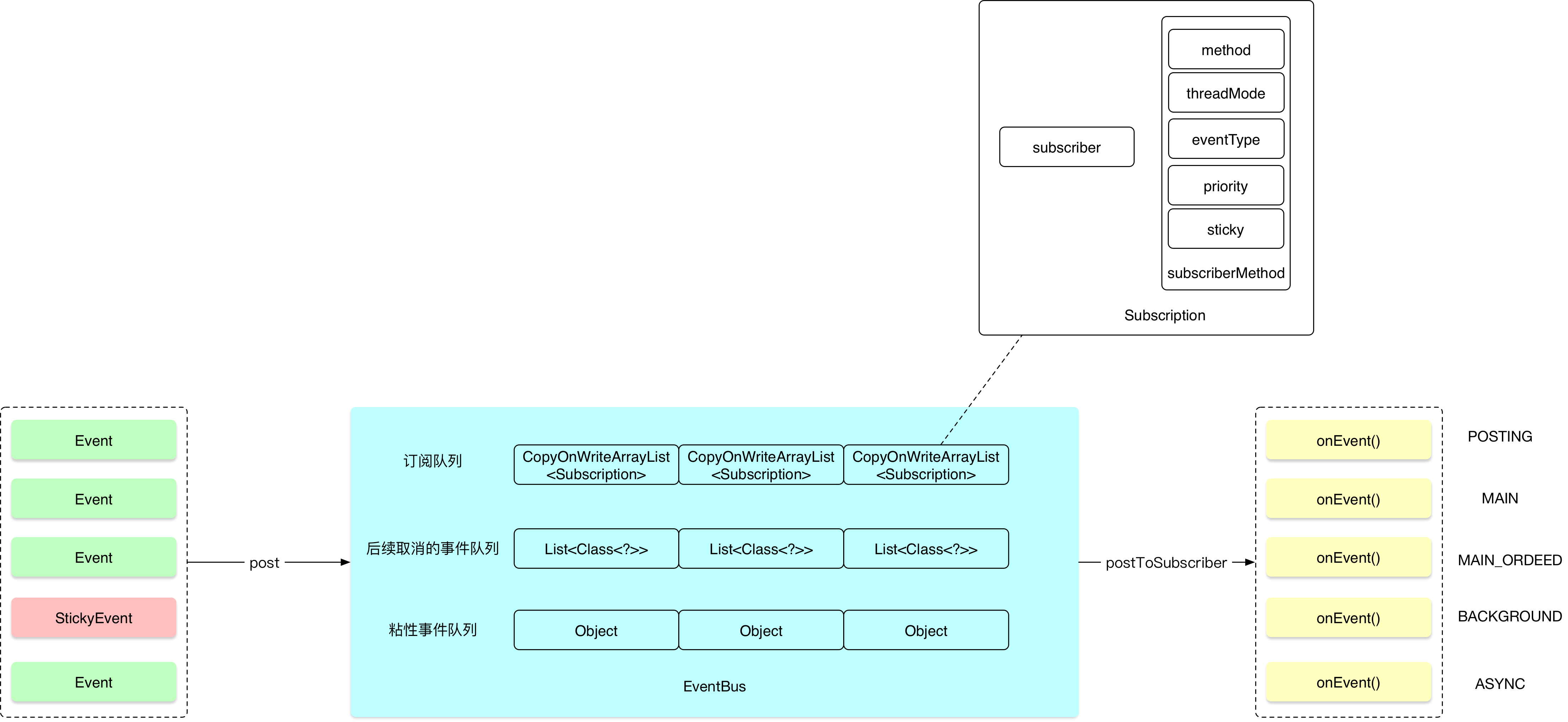一 、简单概括
- EventBus是一个Android/Java平台基于订阅与发布的同通信框架,不支持跨进程。可以用于Activity/Fragment/Thread/Service之间通信解耦,也可以用于多线程通信。
- EventBus相对于BroadcastReceiver、Handler、接口回调的有点在于简单,事件的订阅和发布解耦,但是存在的问题也很明显,会有大量的Event类来管理
- Event bus for Android and Java that simplifies communication between Activities, Fragments, Threads, Services, etc. Less code, better quality.
- GITHUB直连
二、EventBus的基本使用

- 注册订阅者
- 发布、接收Event
- 取消注册订阅者
三、源码解析核心类
分析如下几个类,基本可以理清EventBus的event register/post
EventBus.java对外使用的类和方法Subscription.java其中关键的final Object subscriber; // 订阅者 final SubscriberMethod subscriberMethod; // 订阅者方法SubscriberMethod.java其中关键的final Method method; // 订阅者中的方法 final ThreadMode threadMode; // 回调的线程模式 final Class<?> eventType; // Event类型,订阅Map的Key final int priority; // 优先级 final boolean sticky; // 是否粘性
1. 注册订阅者
EventBus.getDefault().register(this)
getDefault() 为单例获取方法,也可以使用EventBusBuilder实现实例1
2
3
4
5
6
7
8
9
10
11
12
13
14
15
16
17
18
19
20
// 订阅队列,**Map的Key为Event实例**,会将一组注册相同Event的归纳仅一个集合
private final Map<Class<?>, CopyOnWriteArrayList<Subscription>> subscriptionsByEventType;
// 后续准备取消的事件队列
private final Map<Object, List<Class<?>>> typesBySubscriber;
// 粘性事件队列
private final Map<Class<?>, Object> stickyEvents;
public void register(Object subscriber) {
// 1. 获取订阅者的类名。
Class<?> subscriberClass = subscriber.getClass();
// 2. 查找当前订阅者的所有响应函数,即使用注解@Subscribe(threadMode = ThreadMode.MAIN)标记的方法,并将其得以封装在SubscriberMethod对象中
List<SubscriberMethod> subscriberMethods = subscriberMethodFinder.findSubscriberMethods(subscriberClass);
synchronized (this) {
// 3. 循环每个事件响应函数
for (SubscriberMethod subscriberMethod : subscriberMethods) {
subscribe(subscriber, subscriberMethod);
}
}
}
如下是真正subscribe()的过程1
2
3
4
5
6
7
8
9
10
11
12
13
14
15
16
17
18
19
20
21
22
23
24
25
26
27
28
29
30
31
32
33
34
35
36
37
38
39
40
41
42
43
44
45
46
47
48
49
50
51
52
53
54
55private void subscribe(Object subscriber, SubscriberMethod subscriberMethod) {
// 事件类型(xxxEvent)
Class<?> eventType = subscriberMethod.eventType;
// 1.将订阅者和订阅者的方法归纳到另一个对象中
Subscription newSubscription = new Subscription(subscriber, subscriberMethod);
// 2.拿到该事件类型的所有订阅信息。
CopyOnWriteArrayList<Subscription> subscriptions = subscriptionsByEventType.get(eventType);
if (subscriptions == null) {
// 如果未有相同事件注册过,则创建一个此Event订阅列表
subscriptions = new CopyOnWriteArrayList<>();
subscriptionsByEventType.put(eventType, subscriptions);
} else {
if (subscriptions.contains(newSubscription)) {
throw new EventBusException("Subscriber " + subscriber.getClass() + " already registered to event " + eventType);
}
}
int size = subscriptions.size();
// 3. 按照事件优先级将其插入订阅者列表中,其实就是插入顺序
for (int i = 0; i <= size; i++) {
if (i == size || subscriberMethod.priority > subscriptions.get(i).subscriberMethod.priority) {
subscriptions.add(i, newSubscription);
break;
}
}
// 4. 得到当前订阅者订阅的所有事件队列,存放在typesBySubscriber中,用于后续取消事件订阅。
List<Class<?>> subscribedEvents = typesBySubscriber.get(subscriber);
if (subscribedEvents == null) {
subscribedEvents = new ArrayList<>();
typesBySubscriber.put(subscriber, subscribedEvents);
}
subscribedEvents.add(eventType);
// 5. 是否是粘性事件,如果是粘性事件,则从stickyEvents队列中取出最后一个该类型的事件发送给订阅者。
if (subscriberMethod.sticky) {
if (eventInheritance) {
// Existing sticky events of all subclasses of eventType have to be considered.
// Note: Iterating over all events may be inefficient with lots of sticky events,
// thus data structure should be changed to allow a more efficient lookup
// (e.g. an additional map storing sub classes of super classes: Class -> List<Class>).
Set<Map.Entry<Class<?>, Object>> entries = stickyEvents.entrySet();
for (Map.Entry<Class<?>, Object> entry : entries) {
Class<?> candidateEventType = entry.getKey();
if (eventType.isAssignableFrom(candidateEventType)) {
Object stickyEvent = entry.getValue();
checkPostStickyEventToSubscription(newSubscription, stickyEvent);
}
}
} else {
Object stickyEvent = stickyEvents.get(eventType);
checkPostStickyEventToSubscription(newSubscription, stickyEvent);
}
}
}
2. 发布事件
EventBus.getDefault().post(new Event("Event Message"));
其具体的串联过程如下:post() -> postSingleEvent)() -> postSingleEventForEventType() -> postToSubscription() -> invokeSubscriber() -> subscription.subscriberMethod.method.invoke(subscription.subscriber, event); -> 最终通过反射调用订阅者的onEvent(),得以将消息传递
1 | public void post(Object event) { |
PostingThreadState用来描述发送事件的线程的相关状态信息,包含事件队列,是否是主线程、订阅者、事件Event等信息。
- 获取当前线程的PostingThreadState对象,该对象包含事件队列,保存在ThreadLocal中。
- 将当前事件加入到该线程的事件队列中。
- 判断事件是否在分发中。如果没有则遍历事件队列进行实际分发。
- 进行事件分发。
然后调用postSingleEvent()进行事件分发。
1 | private void postSingleEvent(Object event, PostingThreadState postingState) throws Error { |
该方法主要做了以下事情:
- 如果事件允许继承,则查找该事件类型的所有父类和接口,依次进行循环。
- 查找该事件的所有订阅者。
然后调用postSingleEventForEventType()方法查询当前事件的所有订阅者,如下所示:
1 | private boolean postSingleEventForEventType(Object event, PostingThreadState postingState, Class<?> eventClass) { |
该方法主要做了以下事情:
- 获取当前事件的所有订阅者。
- 遍历所有订阅者。
- 根据订阅者所在线程,调用事件响应函数onEvent()。
调用postToSubscription()方法根据订阅者所在线程,调用事件响应函数onEvent(),这便涉及到接收事件Event的处理了,我们接着来看。
1 | private void postToSubscription(Subscription subscription, Object event, boolean isMainThread) { |
1 | (threadMode = ThreadMode.MAIN) |
如上所示,onEvent函数上是可以加Subscribe注解了,该注解标明了onEvent()函数在哪个线程执行。主要有以下几个线程:
- PostThread:默认的 ThreadMode,表示在执行 Post 操作的线程直接调用订阅者的事件响应方法,不论该线程是否为主线程(UI 线程)。当该线程为主线程
时,响应方法中不能有耗时操作,否则有卡主线程的风险。适用场景:对于是否在主线程执行无要求,但若 Post 线程为主线程,不能耗时的操作; - MainThread:在主线程中执行响应方法。如果发布线程就是主线程,则直接调用订阅者的事件响应方法,否则通过主线程的 Handler 发送消息在主线程中处理—
—调用订阅者的事件响应函数。显然,MainThread类的方法也不能有耗时操作,以避免卡主线程。适用场景:必须在主线程执行的操作; - BackgroundThread:在后台线程中执行响应方法。如果发布线程不是主线程,则直接调用订阅者的事件响应函数,否则启动唯一的后台线程去处理。由于后台线程
是唯一的,当事件超过一个的时候,它们会被放在队列中依次执行,因此该类响应方法虽然没有PostThread类和MainThread类方法对性能敏感,但最好不要有重度耗
时的操作或太频繁的轻度耗时操作,以造成其他操作等待。适用场景:操作轻微耗时且不会过于频繁,即一般的耗时操作都可以放在这里; - Async:不论发布线程是否为主线程,都使用一个空闲线程来处理。和BackgroundThread不同的是,Async类的所有线程是相互独立的,因此不会出现卡线程的问
题。适用场景:长耗时操作,例如网络访问。
这里我线程执行和EventBus的成员变量对应,它们都实现了Runnable与Poster接口,Poster接口定义了事件排队功能,这些本质上都是个Runnable,放在线程池里执行,如下所示:
private final Poster mainThreadPoster;
private final BackgroundPoster backgroundPoster;
private final AsyncPoster asyncPoster;
private final SubscriberMethodFinder subscriberMethodFinder;
private final ExecutorService executorService;
3. 取消订阅
取消注册订阅者调用的是以下方法:
1 | EventBus.getDefault().unregister(this); |
具体如下所示:
1 | public synchronized void unregister(Object subscriber) { |
取消注册订阅者的流程也十分简单,如下所示:
- 获取当前订阅者订阅的所有事件类型。
- 遍历事件队列,解除事件注册。
- 移除事件订阅者。
当猴调用unsubscribeByEventType()移除订阅者,如下所示:
1 | private void unsubscribeByEventType(Object subscriber, Class<?> eventType) { |
四、总结
EventBus中使用到了现在一些比较主流的技术,注解、反射、ThreadLocal,组成了订阅发布的一组框架,从中能看到作者对Event的理解,以及在架构时对效率的考虑。从以eventClazz为Key,映射出所有订阅者的思想,和现实中以一对多的思想类似,代码的思想不是一点点得来的,停下笔思考一下,如何才会更好?文中大多是从网上得来,只算自己的一种归纳整理吧。